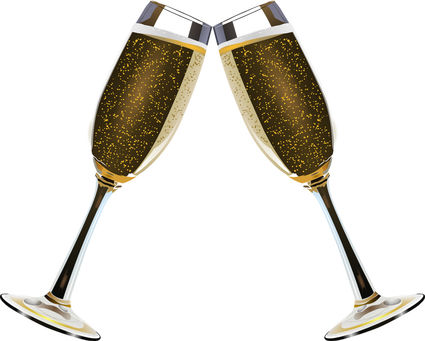Toast to the New Year
December 26, 2019
As the clock nears midnight on New Year's Eve, many pop the cork on a bottle of bubbly, offering a toast to new beginnings.
What makes the popular French luxury a must-have when the clock ticks midnight?
The sparkling wine's roots feature an embodiment of religion and royalty.
In the fifth century, wine from the Champagne region in France was used during the baptism of King Clovis. While the wine used more than likely wasn't of the sparkling variety, it resembled a chardonnay or pinot noir.
According to the Christie's Encyclopedia of Champagne and Sparkling Wine, in 1662, English scientist Christopher Merret introduced a cider with sugar added to it, which produced a fizzy effect.
Thirty years later, French monk Dom Perignon accidentally stumbled on the secret of magic bubbles.
Historical accounts note that wine bottled by Perignon did not ferment in the fall. Instead, when spring temperatures rose, secondary fermentation, caused by dormant yeast, produced carbon dioxide bubbles.
Perignon dubbed the liquid "the devil's wine," after bottles would explode.
During the 1700s, the popularity of the drink spread across Europe and was a symbol of wealth.
King Louis XV ordered that only wines from Champagne could be shipped in glass bottles. The decree benefited the king, since the decadent drink would have to be purchased from Champagne-area vintners.
A decade later, artists and authors wove the drink into their works, making Champagne a beverage marketed to the masses as a worthwhile luxury.
Champagne became associated with life's milestones - weddings and birth of babies - and was used as a sign of good luck when christening a new ship.
By 1900, 30 million bottles of Champagne were shipped all over the world.
During World War I, the Champagne region, located two hours north of Paris, was beaten by heavy artillery fire. When the armistice was inked in 1918, many of the vineyards in the region were destroyed.
Grape growers from Champagne houses in Reims and Epernay capitalized on the drink's popularity, mounting mass marketing campaigns touting Champagne as a fashionable choice for everyone.
Now, more than 15,800 growers raise grapes in Champagne. Most do not produce wines.
Instead, Champagne houses control two-thirds of the production.
Five types of the sparkling wine are produced.
Non-vintage accounts for 85% of Champagne. This means it may contain wine from several years. Minimum aging is 15 months.
Vintage wine is from the year and is aged at least 36 months.
Blanc de Blanc is made strictly from Chardonnay, while Blanc de Noir is a blend of black grape varieties, including Pinot Noir or Meunier.
Rosé, or pink, Champagne is a blend of red and white wines.




Reader Comments(0)